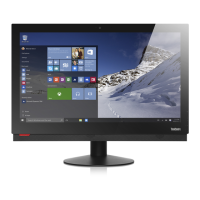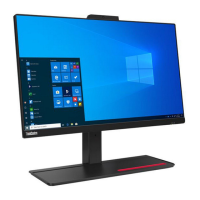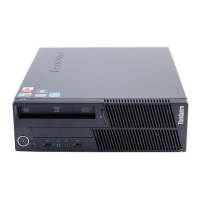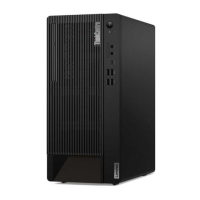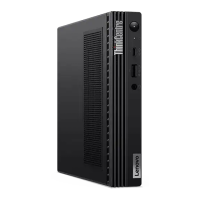Do you have a question about the Lenovo ThinkCentre M900z and is the answer not in the manual?
Locates the computer's internal and external hardware components.
Details the various features and capabilities of the computer system.
Lists the physical and technical specifications of the computer.
Information on pre-installed software and utilities available on the computer.
Instructions for positioning the computer display for optimal viewing comfort.
Steps for establishing a wired or wireless network connection for the computer.
Precautions and guidelines for servicing and upgrading computer components.
Locates the computer's internal and external hardware components.
Details the various features and capabilities of the computer system.
Step-by-step guide to launching applications from Windows.
Details how to adjust the tilt angle of the monitor stand.
Step-by-step instructions for inserting and ejecting discs.
Methods for burning discs using built-in Windows features.
Guidance on setting up an ergonomic and efficient workspace.
Enables voice control of the computer for various tasks.
Key practices to ensure optimal computer performance and data protection.
How to obtain and install the most recent drivers for computer hardware.
Methods to secure the computer using physical or software locking devices.
Techniques to protect the computer and data from unauthorized use.
How to set up and use fingerprint scanning for secure login.
Overview of the BIOS/UEFI setup utility for system configuration.
How to manage hardware device access through the Setup Utility.
Explains the different password options available in the BIOS setup.
A systematic approach to diagnosing and fixing computer issues.
Finding solutions for specific computer problems based on symptoms.
Solutions for issues preventing the computer from booting correctly.
Resolving issues where drives are not detected in BIOS.
Troubleshooting a black screen during operation.
Resolving issues with establishing an Ethernet connection.
Steps to resolve problems with the computer's Wi-Fi adapter.
Resolving issues where Bluetooth is not functioning.
Resolving problems when a USB device is not recognized.
Resolving issues caused by faulty or outdated device drivers.
Procedures for recovering the Windows 7 operating system.
Locating useful information and resources for computing needs.
Information on how to get technical assistance and support.
FCC compliance statement for digital device emissions.
Procedures for recycling computers and monitors in Japan.
Proper disposal methods for lithium batteries and packs.
Compliance with EU directives regarding hazardous substances.
Locates the computer's internal and external hardware components.
Details the various features and capabilities of the computer system.
Lists the physical and technical specifications of the computer.
Information on pre-installed software and utilities available on the computer.
Instructions for positioning the computer display for optimal viewing comfort.
Steps for establishing a wired or wireless network connection for the computer.
Precautions and guidelines for servicing and upgrading computer components.
Locates the computer's internal and external hardware components.
Details the various features and capabilities of the computer system.
Step-by-step guide to launching applications from Windows.
Details how to adjust the tilt angle of the monitor stand.
Step-by-step instructions for inserting and ejecting discs.
Methods for burning discs using built-in Windows features.
Guidance on setting up an ergonomic and efficient workspace.
Enables voice control of the computer for various tasks.
Key practices to ensure optimal computer performance and data protection.
How to obtain and install the most recent drivers for computer hardware.
Methods to secure the computer using physical or software locking devices.
Techniques to protect the computer and data from unauthorized use.
How to set up and use fingerprint scanning for secure login.
Overview of the BIOS/UEFI setup utility for system configuration.
How to manage hardware device access through the Setup Utility.
Explains the different password options available in the BIOS setup.
A systematic approach to diagnosing and fixing computer issues.
Finding solutions for specific computer problems based on symptoms.
Solutions for issues preventing the computer from booting correctly.
Resolving issues where drives are not detected in BIOS.
Troubleshooting a black screen during operation.
Resolving issues with establishing an Ethernet connection.
Steps to resolve problems with the computer's Wi-Fi adapter.
Resolving issues where Bluetooth is not functioning.
Resolving problems when a USB device is not recognized.
Resolving issues caused by faulty or outdated device drivers.
Procedures for recovering the Windows 7 operating system.
Locating useful information and resources for computing needs.
Information on how to get technical assistance and support.
FCC compliance statement for digital device emissions.
Procedures for recycling computers and monitors in Japan.
Proper disposal methods for lithium batteries and packs.
Compliance with EU directives regarding hazardous substances.
| Panel type | TFT |
|---|---|
| Screen shape | Flat |
| LED backlight | Yes |
| Display diagonal | 23.8 \ |
| Native aspect ratio | 16:9 |
| Intel segment tagging | Enterprise, Professional |
| Memory slots | 2 |
| Internal memory | 8 GB |
| Memory slots type | SO-DIMM |
| Memory clock speed | 2133 MHz |
| Memory form factor | DIMM/SO-DIMM |
| Internal memory type | DDR4-SDRAM |
| Maximum internal memory | 32 GB |
| Memory layout (slots x size) | 1 x 8 GB |
| HDD speed | 7200 RPM |
| Storage media | HDD |
| Optical drive type | DVD±RW |
| Total storage capacity | 500 GB |
| Number of storage drives installed | 1 |
| On-board graphics card ID | 1912 |
| Discrete graphics card model | Not available |
| On-board graphics card model | Intel® HD Graphics 530 |
| On-board graphics card family | Intel® HD Graphics |
| Maximum on-board graphics card memory | 1.74 GB |
| On-board graphics card OpenGL version | 4.4 |
| On-board graphics card base frequency | 350 MHz |
| On-board graphics card DirectX version | 12.0 |
| On-board graphics card dynamic frequency (max) | 1050 MHz |
| Number of displays supported (on-board graphics) | 3 |
| Product color | Black |
| Product type | All-in-One PC |
| RMS rated power | 6 W |
| Wi-Fi standards | 802.11a, Wi-Fi 5 (802.11ac), 802.11b, 802.11g, Wi-Fi 4 (802.11n) |
| Ethernet LAN data rates | 10, 100, 1000 Mbit/s |
| AC adapter power | 150 W |
| USB 2.0 ports quantity | 0 |
| USB 3.2 Gen 1 (3.1 Gen 1) Type-A ports quantity | 6 |
| Recovery operating system | Windows 10 Pro |
| Operating system installed | Windows 7 Professional |
| Operating system architecture | 64-bit |
| Tcase | 71 °C |
| Bus type | DMI3 |
| Stepping | R0 |
| Processor code | SR2BX |
| Processor cache | 6 MB |
| Processor model | i5-6500 |
| System bus rate | 8 GT/s |
| Processor family | Intel® Core™ i5 |
| Processor series | Intel Core i5-6500 Desktop series |
| Processor socket | LGA 1151 (Socket H4) |
| Processor threads | 4 |
| Processor codename | Skylake |
| Processor frequency | 3.2 GHz |
| Processor cache type | Smart Cache |
| Processor lithography | 14 nm |
| Processor manufacturer | Intel |
| Processor front side bus | - MHz |
| PCI Express slots version | 3.0 |
| Processor boost frequency | 3.6 GHz |
| PCI Express configurations | 1x16, 2x8, 1x8+2x4 |
| Thermal Design Power (TDP) | 65 W |
| Maximum number of PCI Express lanes | 16 |
| Memory types supported by processor | DDR3L-SDRAM, DDR4-SDRAM |
| Memory voltage supported by processor | 1.35 V |
| Memory channels supported by processor | Dual |
| Memory clock speeds supported by processor | 2133, 1333, 1600, 1866 MHz |
| Memory bandwidth supported by processor (max) | 34.1 GB/s |
| Maximum internal memory supported by processor | 64 GB |
| Scalability | 1S |
| Processor ARK ID | 88184 |
| Processor package size | 37.5 x 37.5 mm |
| Supported instruction sets | SSE4.2, AVX 2.0, SSE4.1 |
| Thermal solution specification | PCG 2015C |
| Intel Stable Image Platform Program (SIPP) version | 1.00 |
| Depth (with stand) | 253 mm |
|---|---|
| Height (with stand) | 505 mm |
| Weight (with stand) | 9400 g |
| Depth (without stand) | 45 mm |
| Width (without stand) | 584 mm |
| Height (without stand) | 390 mm |
| Weight (without stand) | 6800 g |

